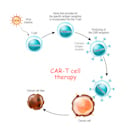
Advances in Diabetes, Part I: Injectable Medications
There have been many advances in the treatment of diabetes over the last several decades. With these rapid changes, it is important for healthcare professionals, particularly nurses, to be aware of medications that may be used to treat diabetic patient.
Insulin is required for patients with type I diabetes mellitus (also known as juvenile diabetes, or new-onset diabetes). In this form of diabetes, the pancreas does not make any insulin at all (American Diabetes Association [ADA], 2016b). Conversely, for patients with type II diabetes, the body does not use insulin effectively, known as insulin resistance. Patients with type II diabetes may also benefit from insulin if other regimens have not worked (ADA, 2016c). In addition to insulin, there are injectable medications for both type I and type II diabetics.
Rapid-acting insulins
The number of available insulins on the market continues to grow. Rapid-acting insulins include:
Aspart (Novolog®)
The insulin aspart (Novolog) is a clear liquid, used in syringes, pumps, or pens, and may be given subcutaneously (subq) or intravenous (IV). The onset is 10 to 20 minutes, with a peak of 30 to 90 minutes. The duration of aspart is 3 to 5 hours (Curry, 2015).
Lispro (Humalog®, available in U-100 and U-200)
Another rapid acting insulin, lispro (Humalog), is also a clear liquid, used in syringes, pumps, or pens, and may be given subq or IV. The onset is 10 to 20 minutes, with a peak of 30 to 90 minutes. The duration of lispro is 3 to 5 hours (Curry, 2015).
Glulisine (Apidra®)
The insulin glulisine (Apidra) is also in clear form, used in syringes, pumps, or pens, and can also be given subq or IV. The onset is 10 to 20 minutes, with a peak of 30 to 90 minutes. The duration of lispro is 3 to 5 hours (Curry, 2015).
Inhaled Insulin Human (Afrezza®)
The inhaled insulin human Afrezza is an inhaled powder for type I and II adults. The onset is 12 to 15 minutes, with a peak of 30 minutes, and a duration of 3 hours. Afrezza is not for treatment of diabetic ketoacidosis (DKA), and has a risk of acute bronchospasm in patients with asthma or chronic obstructive pulmonary disorder (COPD). A patient should be a nonsmoker for at least 6 months before using this treatment. Pulmonary function should be tested at baseline, 6 months, and then annually (Curry, 2015; Peter, 2015).
Considerations of rapid-acting insulins include administration 10 to 20 minutes before each main meal, a dosing schedule that can be customized when adding to a type II regimen, with the main side effect of hypoglycemia (Curry, 2015; Peter, 2015).
Short-acting, or Regular Insulins
Included in the category of short-acting or regular insulins are:
Humulin® R, and Humulin R U-500
Both Humulin R and Novolin R are clear, for use in syringes only, and can be given subq or IV. The onset of regular insulin is 30 to 60 minutes, with a peak of 2 to 4 hours, and a duration of 5 to 8 hours (Curry, 2015).
Novolin® R.
Intermediate-acting insulin (also known as NPH) is available in Humulin N and Novolin N. Considerations with these insulins include usual administration before breakfast and at bedtime. Nocturnal hypoglycemia is a higher risk if dosing is done with dinner rather than bedtime (Curry, 2015; Peter, 2015).
Both Humulin N and Novolin N are cloudy insulins, which require mixing before each dose, and may be mixed in the same syringe as an R insulin. Both “N” insulins are available for syringe use, but only Humulin N is available in a pen. These insulins must be given subq only. The “N” insulins have an onset of 1 to 3 hours, with a peak of 8 hours, and a duration of 12 to 16 hours (Curry, 2015).
Considerations of short-acting or regular insulins include administration 30 to 60 minutes before breakfast and dinner, with the main side effect of hypoglycemia (Curry, 2015; Peter, 2015).
Long-acting Insulins
Long-acting insulins include:
Insulin Detemir (Levemir®)
The insulin detemir (Levemir) is a clear insulin, available for a syringe or in a pen, and must be given subq. The onset is 1 hour, with no pronounced peak, and a duration of 20 to 26 hours (Curry, 2015).
Glargine U-100 (Lantus® or Basaglar®)
The insulin glargine U-100 is known as either Lantus or Basaglar, and is a clear insulin which is used in a syringe or pen for subq administration. The onset of glargine is 1 hour, with no pronounced peak, and a duration of 20 to 26 hours. Basaglar has not been studied in children less than 6 years old (Curry, 2015; Peter, 2015).
Glargine U-300 (Toujeo®)
The insulin glargine U-300 (Toujeo) is considered ultra-long-acting. It is clear, available for a syringe or in a pen, and must be given subq. The onset is in 6 hours, with no pronounced peak, and a duration of 36 hours (Curry, 2015).
Degludec (Tresiba®-U-100 and U-200 available)
Another insulin considered ultra-long acting is degludec (Tresiba-U-100 and U-200). It is also clear, available in a pen, and needs to be administered subq. The onset is in 1 hour, without a peak, and a duration of 42 hours (Novo Nordisk, 2016).
These insulins provide basal or background insulin, usually given once daily but can be given twice daily. Long-acting insulins are not for the treatment of DKA, and do not provide meal coverage. It is not recommended to mix long-acting insulins in the same syringe with another insulin (exception is degludec/aspart 70/30 pen mix) (Curry, 2015; Peter, 2015).
Insulin Mixtures
Insulins also come in mixture forms, which allow variable peaks and durations. These may include insulin degludec/aspart (Ryzodeg® 70/30), Humalog Mix 75/25, Humalog Mix 50/50, Humulin 70/30, Novolin 70/30, and Novolog Mix 70/30. Mixtures contain the properties of the two insulin types in the combination. As related to meals, dose timing is based on the faster-acting insulin contained in the mixture to minimize risk of hypoglycemia (Curry, 2015; Peter, 2015).
The mixture insulin degludec/aspart (Ryzodeg 70/30) includes 70% degludec and 30% aspart insulins. This combination provides both a rapid-acting and a long-acting insulin. It is a clear insulin available in pen, for subq administration with meals. The onset of the insulin is within 15 minutes, based on the rapid-acting portion, with a duration of 42 hours (Curry, 2015; Novo Nordisk, 2016).
The mixes of Humalog Mix 75/25 and Humalog Mix 50/50 contain both lispro protamine and lispro. The 75/25 mix is 75% lispro protamine and 25% lispro, while the 50/50 mix is 50% of each component. Both of these insulins are cloudy, available for syringe and pen, and must be given subq. The onset is 10 to 15 min, with a variable peak, and a duration of 10 to 16 hours (Curry, 2015).
The Humulin 70/30 and Novolin 70/30 insulin mixes are both made of 70% NPH and 30% regular insulin. These are cloudy insulins, with the Humulin® brand available for syringe and pen, and the Novolin brand available for syringe only. The administration is subq only. These insulins have an onset of 30 to 60 minutes, a variable peak, and a duration of 10 to 16 hours (Curry, 2015).
The last mix, Novolog Mix 70/30, consists of 70% aspart protamine and 30% insulin aspart. It is a cloudy mixture, available for syringe and pen, and can be given subq only. The onset is 5 to 15 minutes, with a varied peak, and a duration of 10 to 16 hours (Curry, 2015).
Amylinomimetics
Another group of injectable medications on the market is called amylinomimetics, which is amylin analogs. There are two forms of pramlintide (SymlinPen®), which is available in both 60 mcg and 120 mcg in a pen for subq injection. This medication does not replace insulin but is injected before meals as an adjunct to mealtime insulin.
Considerations include an increased risk of hypoglycemia; possible requirement of insulin dose reduction; reduction of post-meal hyperglycemia; delayed stomach emptying time; reduction of post-meal glucagon secretion; reduction of appetite; and is approved for adults only (ADA, 2016a).
Glucagon-like peptides (GLP-1)
The last group of injectable medications to be discussed is (glucagon-like peptides (GLP-1), also known as receptor agonists. Currently, these medications are approved for type II diabetes only. These medications include:
- Albiglutide (Tanzeum®)
- Dulaglutide (Trulicity®)
- Exenatide (Byetta®)
- Extended-release exenatide (Bydereon®)
- Liraglutide (Victoza®)
- and Lixisenatide (Adlyxin®)
GLP-1 medications are similar to the natural hormone incretin. They stimulate the pancreas to increase insulin production and suppress glucagon secretion. Appetite can be reduced by slowing the emptying of the stomach. Considerations include:
- GLP-1 is often used in combination with other diabetes therapies such as metformin, glimepiride, pioglitazone, and/or insulin; and inject subcutaneously (with a pen) to upper arm, thigh, or abdomen.
- Tanzeum, Trulicity, and Bydureon are taken once weekly.
- Inject Victoza once daily and Byetta twice daily. There is an increased risk of hypoglycemia if taken with insulin or a secretagogue.
- Take caution with patients who have a history of pancreatitis, severe gastrointestinal diagnosis, personal or family history of medullary thyroid carcinoma (MTC).
- Side effects include nausea, vomiting, diarrhea, abdominal pain, and decreased appetite (ADA, 2016a).
This has provided an overview of injectable medications currently available to treat both type I and type II diabetes mellitus. It is always important for nurses to understand the medications before they give them. Take a few minutes to look up unfamiliar medications prior to administration.
References:
American Diabetes Association. (2016a). Other injectable medications.
American Diabetes Association. (2016b). Type 1 diabetes.
American Diabetes Association. (2016c). Type 2 diabetes.
Curry, A. (2015). Insulin innovations. Diabetes Forecast.
Novo Nordisk. (2016). Tresiba.
Peter, A. (2015). New insulins: Benefits and challenges. Medscape.




